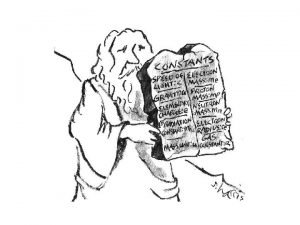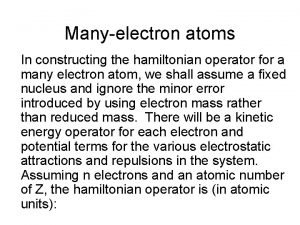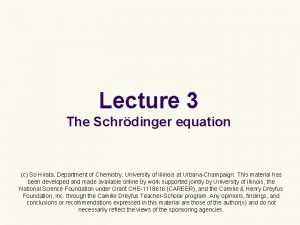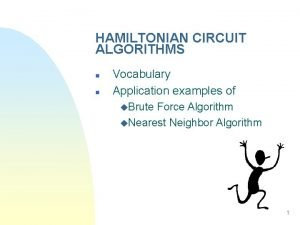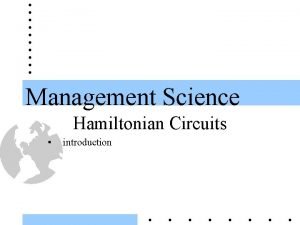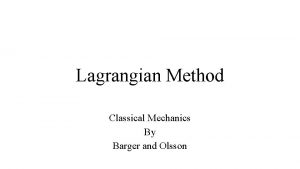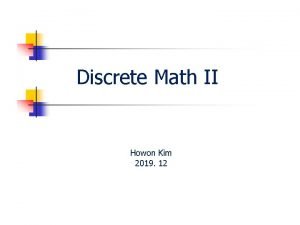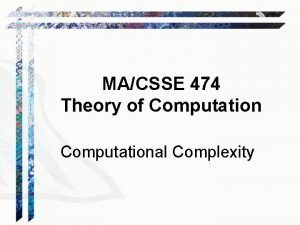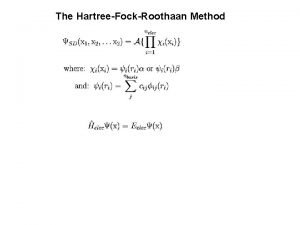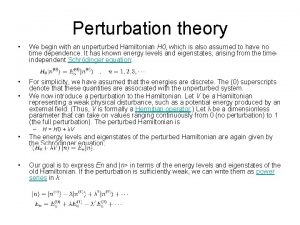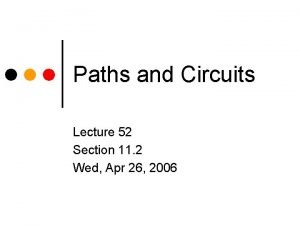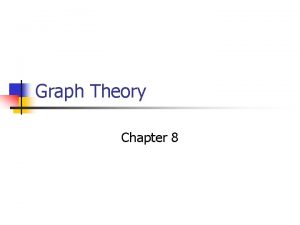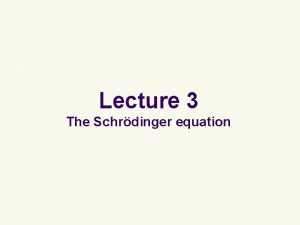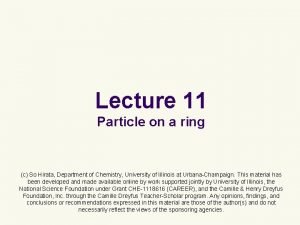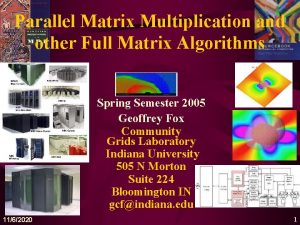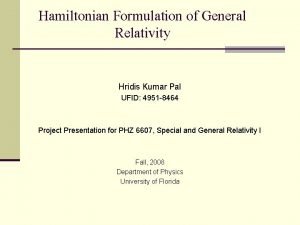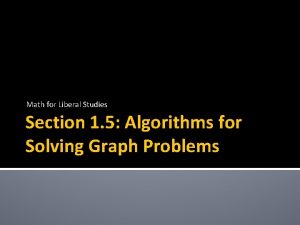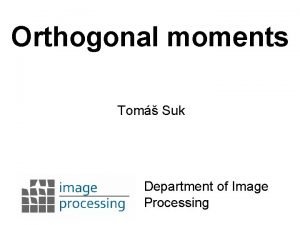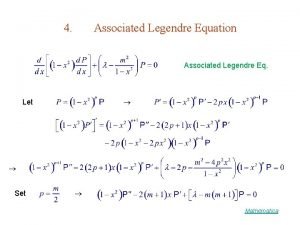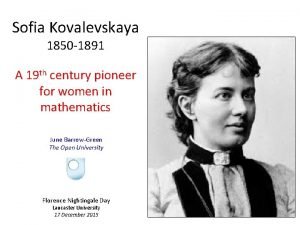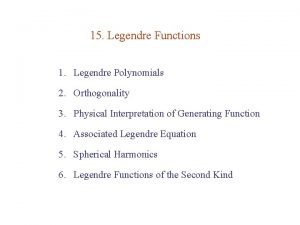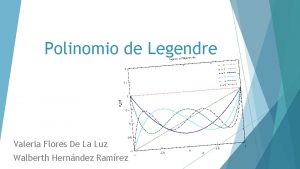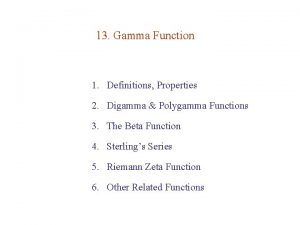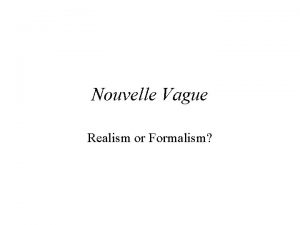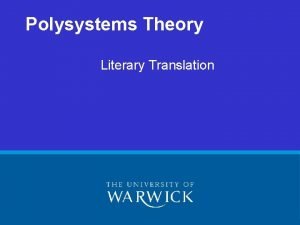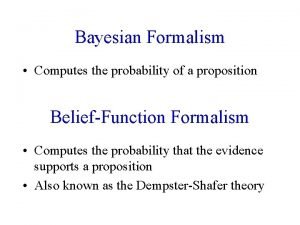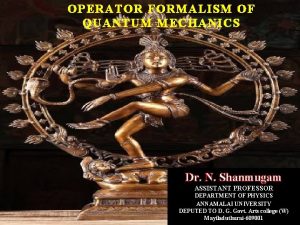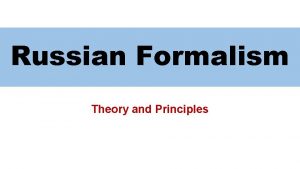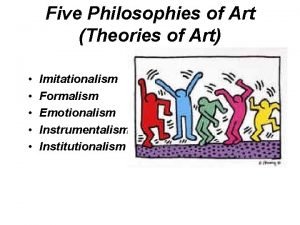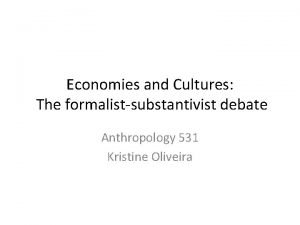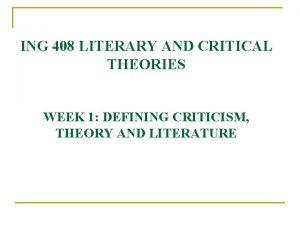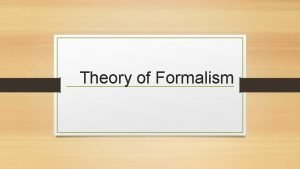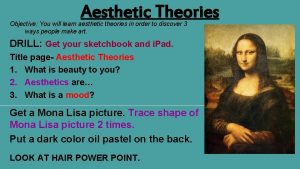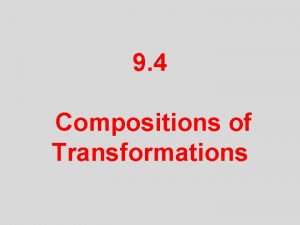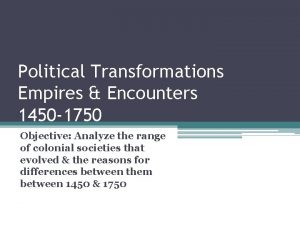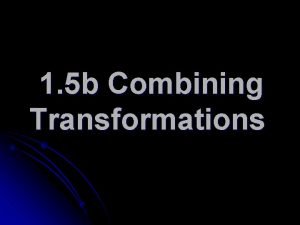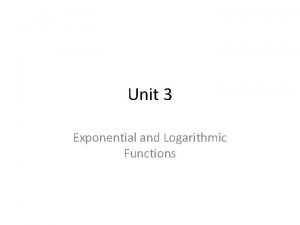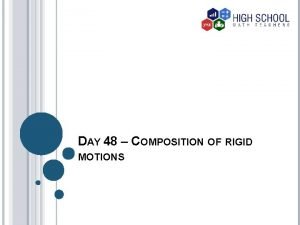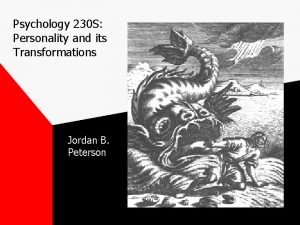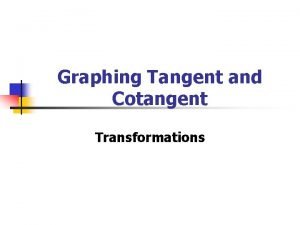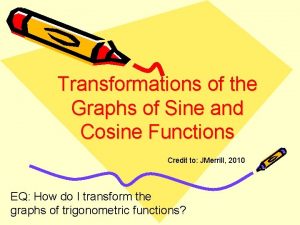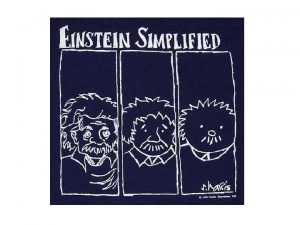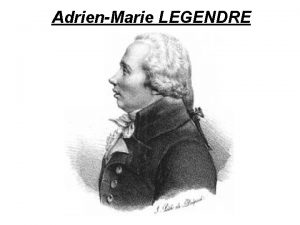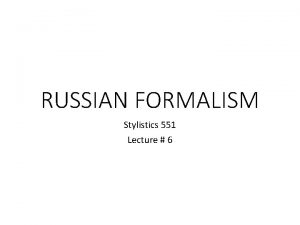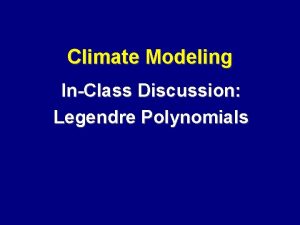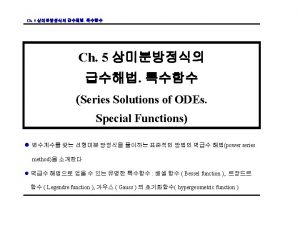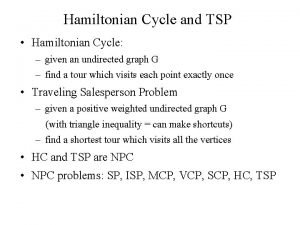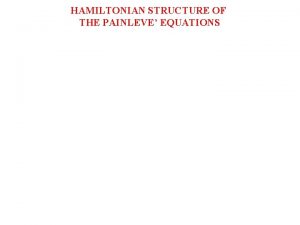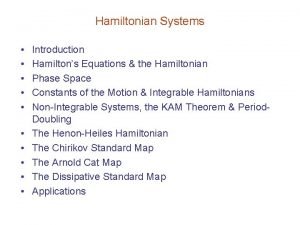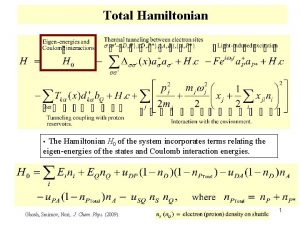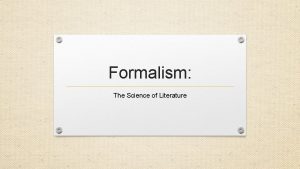Hamiltonian Formalism Legendre transformations Legendre transformation AdrienMarie Legendre
















































































- Slides: 80

Hamiltonian Formalism

Legendre transformations • Legendre transformation: Adrien-Marie Legendre (1752 – 1833)

What is H? • Conjugate momentum • Then • So

What is H?

What is H?

What is H? • If • Then • Kinetic energy • In generalized coordinates

What is H? • For scleronomous generalized coordinates • Then • If

What is H? • For scleronomous generalized coordinates, H is a total mechanical energy of the system (even if H depends explicitly on time) • If H does not depend explicitly on time, it is a constant of motion (even if is not a total mechanical energy) • In all other cases, H is neither a total mechanical energy, nor a constant of motion

Hamilton’s equations • Hamiltonian: • Hamilton’s equations of motion: Sir William Rowan Hamilton (1805 – 1865)

Hamiltonian formalism • For a system with M degrees of freedom, we have 2 M independent variables q and p: 2 M-dimensional phase space (vs. configuration space in Lagrangian formalism) • Instead of M second-order differential equations in the Lagrangian formalism we work with 2 M first-order differential equations in the Hamiltonian formalism • Hamiltonian approach works best for closed holonomic systems • Hamiltonian approach is particularly useful in quantum mechanics, statistical physics, nonlinear physics, perturbation theory

Hamiltonian formalism for open systems

Hamilton’s equations in symplectic notation • Construct a column matrix (vector) with 2 M elements • Then • Construct a 2 Mx 2 M square matrix as follows:

Hamilton’s equations in symplectic notation • Then the equations of motion will look compact in the symplectic (matrix) notation: • Example (M = 2):

Lagrangian to Hamiltonian • Obtain conjugate momenta from a Lagrangian • Write a Hamiltonian • Obtain from • Plug into the Hamiltonian to make it a function of coordinates, momenta, and time

Lagrangian to Hamiltonian • For a Lagrangian quadratic in generalized velocities • Write a symplectic notation: • Then a Hamiltonian • Conjugate momenta

Lagrangian to Hamiltonian • Inverting this equation • Then a Hamiltonian

Example: electromagnetism

Example: electromagnetism

Hamilton’s equations from the variational principle • Action functional : • Variations in the phase space :

Hamilton’s equations from the variational principle • Integrating by parts

Hamilton’s equations from the variational principle • For arbitrary independent variations

Conservation laws • If a Hamiltonian does not depend on a certain coordinate explicitly (cyclic), the corresponding conjugate momentum is a constant of motion • If a Hamiltonian does not depend on a certain conjugate momentum explicitly (cyclic), the corresponding coordinate is a constant of motion • If a Hamiltonian does not depend on time explicitly, this Hamiltonian is a constant of motion

Higher-derivative Lagrangians • Let us recall: • Lagrangians with i > 1 occur in many systems and theories: 1. Non-relativistic classical radiating charged particle (see Jackson) 2. Dirac’s relativistic generalization of that 3. Nonlinear dynamics 4. Cosmology 5. String theory 6. Etc.

Higher-derivative Lagrangians • For simplicity, consider a 1 D case: • Variation Mikhail Vasilievich Ostrogradsky (1801 - 1862)

Higher-derivative Lagrangians

Higher-derivative Lagrangians

Higher-derivative Lagrangians • Generalized coordinates/momenta:

Higher-derivative Lagrangians • Euler-Lagrange equations: • We have formulated a ‘higher-order’ Lagrangian formalism • What kind of behavior does it produce?

Example

Example

Example • H is conserved and it generates evolution – it is a Hamiltonian! • Hamiltonian linear in momentum? !? !? ! • No low boundary on the total energy – lack of ground state!!! • Produces ‘runaway’ solutions: the system becomes highly unstable - collapse and explosion at the same time

‘Runaway’ solutions • Unrestricted low boundary of the total energy produces instabilities • Additionally, we generate new degrees of freedom, which require introduction of additional (originally unknown) initial conditions for them • These problems are solved by means of introduction of constraints • Constraints restrict unstable behavior and eliminate unnecessary new degrees of freedom

Canonical transformations • Recall gauge invariance (leaves the evolution of the system unchanged): • Let’s combine gauge invariance with Legendre transformation: • K – is the new Hamiltonian (‘Kamiltonian’ ) • K may be functionally different from H 9. 1

Canonical transformations • Multiplying by the time differential: • So 9. 1

Generating functions • Such functions are called generating functions of canonical transformations • They are functions of both the old and the new canonical variables, so establish a link between the two sets • Legendre transformations may yield a variety of other generating functions 9. 1

Generating functions • We have three additional choices: • Canonical transformations may also be produced by a mixture of the four generating functions 9. 1

An example of a canonical transformation • Generalized coordinates are indistinguishable from their conjugate momenta, and the nomenclature for them is arbitrary • Bottom-line: generalized coordinates and their conjugate momenta should be treated equally in the phase space 9. 2

Criterion for canonical transformations • How to make sure this transformation is canonical? • On the other hand • If • Then 9. 4

Criterion for canonical transformations • Similarly, • If • Then 9. 4

Criterion for canonical transformations • So, • If 9. 4

Canonical transformations in a symplectic form • After transformation • On the other hand 9. 4

Canonical transformations in a symplectic form • For the transformations to be canonical: • Hence, the canonicity criterion is: • For the case M = 1, it is reduced to (check yourself) 9. 4

1 D harmonic oscillator • Let us find a conserved canonical momentum • Generating function 9. 3

1 D harmonic oscillator • Nonlinear partial differential equation for F • Let’s try to separate variables • Let’s try 9. 3

1 D harmonic oscillator • We found a generating function! 9. 3

1 D harmonic oscillator 9. 3

1 D harmonic oscillator 9. 3

Canonical invariants • What remains invariant after a canonical transformation? • Matrix A is a Jacobian of a space transformation • From calculus, for elementary volumes: • Transformation is canonical if 9. 5

Canonical invariants • For a volume in the phase space • Magnitude of volume in the phase space is invariant with respect to canonical transformations: 9. 5

Canonical invariants • What else remains invariant after canonical transformations? 9. 5

Canonical invariants • For M = 1 • For many variables 9. 5

9. 5 Poisson brackets • Poisson brackets: • Poisson brackets are invariant with respect to any canonical transformation Siméon Denis Poisson (1781 – 1840)

Poisson brackets • Properties of Poisson brackets : 9. 5

Poisson brackets • In matrix element notation: • In quantum mechanics, for the commutators of coordinate and momentum operators: 9. 5

Poisson brackets and equations of motion 9. 6

9. 6 Poisson brackets and conservation laws • If u is a constant of motion • If u has no explicit time dependence • In quantum mechanics, conserved quantities commute with the Hamiltonian

9. 6 Poisson brackets and conservation laws • If u and v are constants of motion with no explicit time dependence • For Poisson brackets: • If we know at least two constants of motion, we can obtain further constants of motion

Infinitesimal canonical transformations • Let us consider a canonical transformation with the following generating function (ε – small parameter): • Then 9. 4

Infinitesimal canonical transformations • Multiplying by dt • Then 9. 4

Infinitesimal canonical transformations • Infinitesimal canonical transformations: • In symplectic notation: 9. 4

Evolution generation • Motion of the system in time interval dt can be described as an infinitesimal transformation generated by the Hamiltonian • The system motion in a finite time interval is a succession of infinitesimal transformations, equivalent to a single finite canonical transformation • Evolution of the system is a canonical transformation!!! 9. 6

Application to statistical mechanics • In statistical mechanics we deal with huge numbers of particles • Instead of describing each particle separately, we describe a given state of the system • Each state of the system represents a point in the phase space • We cannot determine the initial conditions exactly • Instead, we study a certain phase volume – ensemble – as it evolves in time 9. 9

Application to statistical mechanics • Ensemble can be described by its density – a number of representative points in a given phase volume • The number of representative points does not change • Ensemble evolution can be thought as a canonical transformation generated by the Hamiltonian • Volume of a phase space is a constant for a canonical transformation 9. 9

Application to statistical mechanics • Ensemble is evolving so its density is evolving too • On the other hand • Liouville’s theorem • In statistical equilibrium Joseph Liouville (1809 -1882) 9. 9

Hamilton–Jacobi theory 10. 1 • We can look for the following canonical transformation, relating the constant (e. g. initial) values of the variables with the current ones: • The reverse transformations will give us a complete solution

Hamilton–Jacobi theory • Let us assume that the Kamiltonian is identically zero • Then • Choosing the following generating function • Then, for such canonical transformation: 10. 1

Hamilton–Jacobi theory • Hamilton–Jacobi equation • Conventionally: 10. 1 Sir William Rowan Hamilton (1805 – 1865) Hamilton’s principal function • Partial differential equation • First order differential equation • Number of variables: M + 1 Karl Gustav Jacobi (1804 – 1851)

Hamilton–Jacobi theory 10. 1 • Suppose the solution exists, so it will produce M + 1 constants of integration: • One constant is evident: • We chose those M constants to be the new momenta • While the old momenta

Hamilton–Jacobi theory 10. 1 • We relate the constants with the initial values of our old variables: • The new coordinates are defined as: • Inverting those formulas we solve our problem

Have we met before? • Remember action? 10. 1

Hamilton’s characteristic function • When the Hamiltonian does not depend on time explicitly • Generating function (Hamilton’s characteristic function) 10. 1

Hamilton’s characteristic function 10. 3 • Now we require: • So: • Detailed comparison of Hamilton’s characteristic vs. Hamilton’s principal is given in a textbook (10. 3)

Hamilton’s characteristic function • What is the relationship between S and W ? • One of possible relationships (the most conventional): 10. 3

Periodic motion • For energies small enough we have periodic oscillations (librations) – green curves • For energies great enough we msy have periodic rotations – red curves • Blue curve – separatrix trajectory – bifurcation transition from librations to rotations 10. 6

Action-angle variables • For either type of periodic motion let us introduce a new variable – action variable (don’t confuse with action!): • A generalized coordinate conjugate to action variable is the angle variable: • The equation of motion for the angle variable: 10. 6

Action-angle variables • In a compete cycle • This is a frequency of the periodic motion 10. 6

Example: 1 D Harmonic oscillator 10. 2

Example: 1 D Harmonic oscillator 10. 2

10. 6 Action-angle variables for 1 D harmonic oscillator • Therefore, for the frequency:

10. 4 Separation of variables in the Hamilton. Jacobi equation • Sometimes, the principal function can be successfully separated in the following way: • For the Hamiltonian without an explicit time dependence: • Functions Hi may or may not be Hamiltonians
 Hamilton's equations of motion
Hamilton's equations of motion Formalistic approach in literature
Formalistic approach in literature Cyclic coordinates in hamiltonian
Cyclic coordinates in hamiltonian Hamiltonian operator
Hamiltonian operator Schrodinger wave equation
Schrodinger wave equation Hamiltonian circuit examples
Hamiltonian circuit examples Grafuri neorientate formule
Grafuri neorientate formule Hamiltonian circuit example
Hamiltonian circuit example Shadow hamiltonian
Shadow hamiltonian Hamiltonian dynamics
Hamiltonian dynamics Hamiltonian circuit
Hamiltonian circuit Chromatic number
Chromatic number Hamiltonian circuit
Hamiltonian circuit The hamiltonian operator is given by
The hamiltonian operator is given by Unperturbed hamiltonian
Unperturbed hamiltonian The hamiltonian operator is given by
The hamiltonian operator is given by Hamiltonian circuit
Hamiltonian circuit Canonical equation of motion
Canonical equation of motion Hamiltonian circuit example
Hamiltonian circuit example Kinetic energy operator
Kinetic energy operator Particle on a ring boundary conditions
Particle on a ring boundary conditions Cannon algorithm
Cannon algorithm Hridis pal
Hridis pal Sorted edges algorithm
Sorted edges algorithm Tom suk
Tom suk Associated legendre polynomials symmetry
Associated legendre polynomials symmetry Sayısal türev
Sayısal türev Adrien-marie legendre
Adrien-marie legendre Quadratura de gauss-legendre
Quadratura de gauss-legendre Matthieu legendre
Matthieu legendre Laguerre polynomials
Laguerre polynomials Matlab legendre polynomial
Matlab legendre polynomial Polinomio de legendre
Polinomio de legendre Identidad de legendre
Identidad de legendre Legendre duplication formula
Legendre duplication formula Manon legendre
Manon legendre Objective correlative
Objective correlative Realism vs formalism in film
Realism vs formalism in film The bayesian network formalism
The bayesian network formalism Formalism/structuralism
Formalism/structuralism Formalism ethics
Formalism ethics Formalism literary theory
Formalism literary theory Russian formalism examples
Russian formalism examples Epic poetry elements
Epic poetry elements Examples of peripeteia in hamlet
Examples of peripeteia in hamlet Formalism new criticism
Formalism new criticism Bayesian formalism
Bayesian formalism Operator formalism in quantum mechanics
Operator formalism in quantum mechanics Formalism in film
Formalism in film Key concepts of russian formalism
Key concepts of russian formalism Formalism in film
Formalism in film What is genre criticism
What is genre criticism Formalism approach
Formalism approach Russian formalism literary theory
Russian formalism literary theory Formalism
Formalism Imitationalism example
Imitationalism example Formalism in economic anthropology
Formalism in economic anthropology Russian formalism
Russian formalism Russian formalism
Russian formalism Imitationalism theory
Imitationalism theory What is criticism in literature
What is criticism in literature Soviet formalism film
Soviet formalism film Formalism ethics
Formalism ethics Emotionalism aesthetic theory
Emotionalism aesthetic theory Sociological criticism definition
Sociological criticism definition Teleological ethics example
Teleological ethics example Reflections in intersecting lines theorem
Reflections in intersecting lines theorem Political transformations empires and encounters
Political transformations empires and encounters Mathisfun tetris
Mathisfun tetris Parent functions and transformations
Parent functions and transformations Combining transformations
Combining transformations Logarithmic function form
Logarithmic function form Transformations grade 9
Transformations grade 9 Energy transformation of oven
Energy transformation of oven Composition of transformations: rigid motions
Composition of transformations: rigid motions Appolinian
Appolinian Transformations flip book
Transformations flip book Graphing tangent transformations worksheet
Graphing tangent transformations worksheet Quantile plot in data mining
Quantile plot in data mining Transformations of sine and cosine functions
Transformations of sine and cosine functions Lorentz transformation derivation
Lorentz transformation derivation


